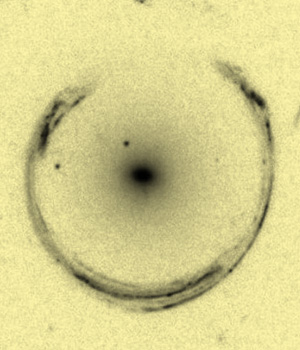Visualizing the Invisible
Dark Matter in the Universe through Gravitational Lenses
MikroMakro Parcours
You may have heard that hydrogen is the most abundant material in the whole Universe. You heard wrong!
It's actually only the second most abundant. Galaxies, one of the largest gravitationally bound objects in the Universe, teach us that the most abundant material is Dark Matter; a mysterious material which (as far as we know) doesn't absorb, emit, or reflect light like normal matter does.
This means it's very hard to see, let alone detect Dark Matter. However, there is an effect which doesn't distinguish between different kinds of matter, gravity. When objects like galaxies become massive enough, they curve space such that not even light takes straight paths. If such a galaxy, a distant light source, and Earth are sufficiently aligned, this gravitational lensing effect is observable. Often, the same light source can then be seen multiple times, or sometimes even imaged as a ring. A picture of such an effect carries a lot of information about the massive lensing object, such as the distribution of Dark Matter and stars, the two main ingredients of galaxies.
Scientific methods enable use to reconstruct those distributions in a lensing analysis. This means, taking pictures of gravitational lenses, effectively makes Dark Matter visible, and brings us just one step closer to unveiling the biggest mystery of the Universe.
PD Dr. Prasenjit Saha does research at the Institute of Physics of the University of Zurich and is a member of the Center for Theoretical Astrophysics and Cosmology. More
Philipp Denzel is PhD student at the Institute for Computational Science at UZH.
Related contributions
